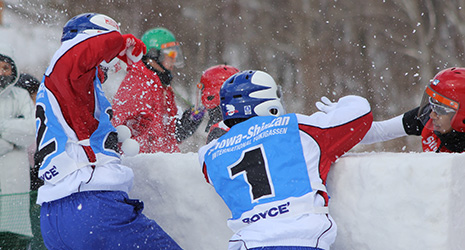Home > Highlighting JAPAN > Highlighting Japan January 2020 > Winter Pleasures
Highlighting JAPAN


The Snowballing Popularity of Yukigassen
Originating in the children’s pastime of throwing snowballs at one another, the popularity of yukigassen as a sport is growing both in Japan and other snowy parts of the world.
The Showa-Shinzan International Yukigassen competition is held every year in the town of Sobetsu, around two hours by train and bus from Sapporo, the capital city of Hokkaido. Yukigassen is the children’s pastime of throwing snowballs at one another, but Showa-Shinzan International Yukigassen is a competitive sporting event based on international rules. Held at the foot of Showa-Shinzan, some 1,400 athletes in 132 teams participated in the 2019 event held on February 23 and 24, with four divisions including the general division and ladies division competing for victory. Under clear skies, the small town of around 2,500 residents attracted crowds of some 27,000 spectators.
Sobetsu has numerous sightseeing spots, including Lake Toya with its large island in the center, and two of Hokkaido’s iconic volcanoes, Showa-Shinzan and Usuzan. Visitors to the town can also enjoy hot springs thanks to the geothermal activity of the area. In winter, however, tourist numbers drop because of heavy snowfall. The International Yukigassen began as a way of attracting visitors during this off-season.
“Most tourists to Sobetsu came in summer and attracting tourists in the winter was a major challenge for the town. But the eruption of Usuzan next to Showa-Shinzan in 1977 caused a drop in summer tourist numbers too, stifling the tourism vibe of the town. The whole town felt that something must be done as a matter of urgency,” says Mimatsu Yasushi, executive director of the Showa-Shinzan International Yukigassen Executive Committee.
This led in 1987 to young residents from sectors such as agriculture, tourism and administration coming together to brainstorm ways of revitalizing their town. Various events were considered, until they came up with the idea of holding a snowball fighting competition, turning yukigassen into a competitive sport.
“One member of the group was moved by the sight of Southeast Asian tourists excited at seeing snow for the first time having fun making snowballs and throwing them at one another. When the other members heard this, they recalled their own experiences of having snowball fights when they were children,” says Mimatsu.
Turning snowball fights into a competitive sport was a totally new idea, so they used other sports as a reference when debating and setting the rules. They also developed special helmets and machines for the mass production of snowballs, with the first competition being held in February 1989.
The game consists of teams of seven players who pelt snowballs on a 36 meter x 10 meter court. Seven shelters (90 centimeters tall and 90 centimeters wide) are distributed around the court, allowing players to take cover. Each match consists of three 3-minute sets, and the first team to win two sets wins the match. Each team can use up to 90 snowballs in each set. Any player struck by a direct snowball hit is eliminated from the set. The team with more remaining players at the end of the set wins. Alternatively, the team that removes the flag of the opposing team or eliminates all the members of the opposing team wins the set. These are the international rules.
Today, similar competitions are held all over the country, from Hokkaido in the north to Oita in Kyushu in the south. Also, in 1994 a team from Kemijärvi in Finland participated in the Showa-Shinzan International Yukigassen after Sobetsu and Kemijärvi became Friendship Cities. The following year, the first overseas competition was held in Finland, with the same players taking part who played a central role. Staff were dispatched from Sobetsu to provide technical guidance, equipment and other support. Later, the sport spread to Scandinavia, North America and Australia, and in 2013 the International Alliance of Yukigassen was founded, consisting of eleven countries.
“I think that it’s human instinct to make snowballs and throw them at one another. That’s why many people can enjoy it. It transcends national borders. I would like to see yukigassen mature as a competitive sport and become a Winter Olympic sporting competition event someday,” says Mimatsu.
© 2009 Cabinet Office, Government of Japan







